Director's Notebook: A Raisin in the Sun - Play Analysis and Staging
VerifiedAdded on 2023/01/13
|23
|2695
|28
Report
AI Summary
This report provides a comprehensive analysis of Lorraine Hansberry's play, "A Raisin in the Sun." It begins with an introduction to the play, its debut, and its cultural significance, including the play's title's origin from Langston Hughes's poem and its setting in Chicago's Woodlawn neighborhood. The report then summarizes the plot, focusing on the Younger family's struggles and aspirations. The core of the analysis delves into the play's cultural context, particularly its direct address of segregated housing and the Civil Rights Movement, as well as the playwright's personal experiences and the societal issues of the time. The report also examines key themes such as race and racism, prejudice and tolerance, sex roles, civil rights, and the American Dream, illustrating how these themes are portrayed through the characters' actions and experiences. Furthermore, it includes creative ideas on the play's setting and staging, and discusses the live theatre performance experience, including production elements and staging concepts. The report concludes with the significance of the play in representing the Black community's working conditions and challenges, as well as its portrayal of the American Dream.
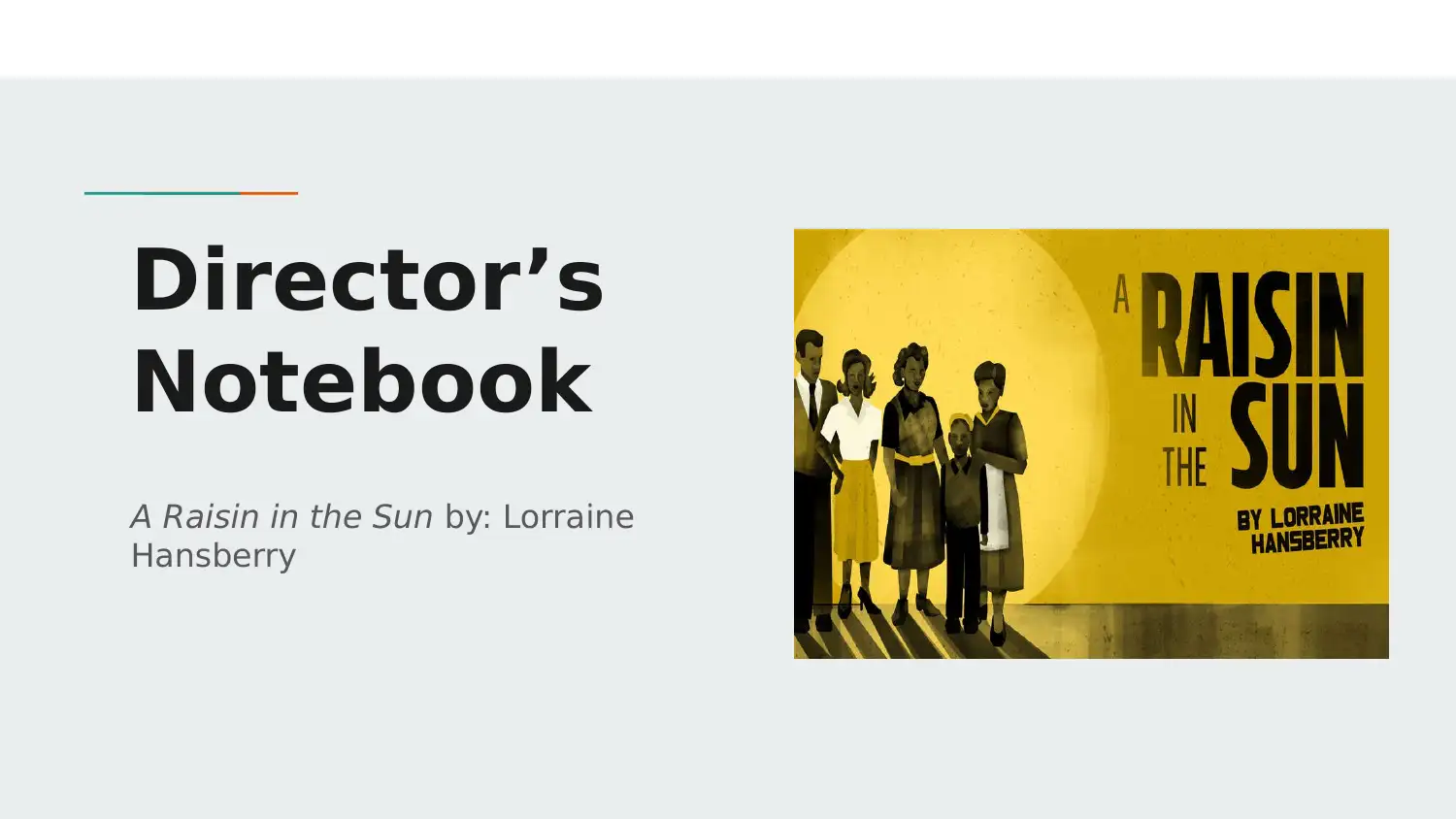
Director’s
Notebook
A Raisin in the Sun by: Lorraine
Hansberry
Notebook
A Raisin in the Sun by: Lorraine
Hansberry
Paraphrase This Document
Need a fresh take? Get an instant paraphrase of this document with our AI Paraphraser
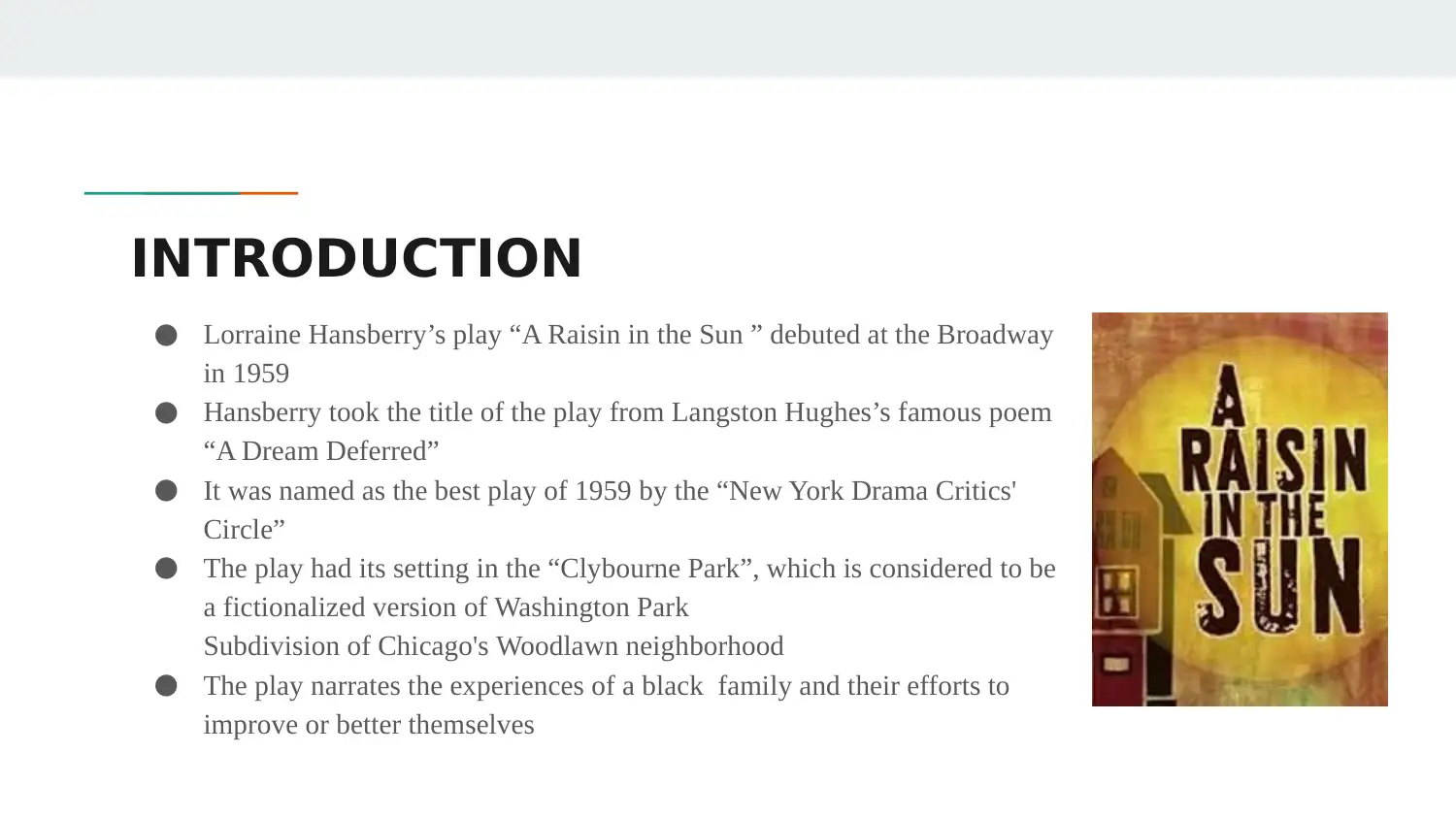
INTRODUCTION
● Lorraine Hansberry’s play “A Raisin in the Sun ” debuted at the Broadway
in 1959
● Hansberry took the title of the play from Langston Hughes’s famous poem
“A Dream Deferred”
● It was named as the best play of 1959 by the “New York Drama Critics'
Circle”
● The play had its setting in the “Clybourne Park”, which is considered to be
a fictionalized version of Washington Park
Subdivision of Chicago's Woodlawn neighborhood
● The play narrates the experiences of a black family and their efforts to
improve or better themselves
● Lorraine Hansberry’s play “A Raisin in the Sun ” debuted at the Broadway
in 1959
● Hansberry took the title of the play from Langston Hughes’s famous poem
“A Dream Deferred”
● It was named as the best play of 1959 by the “New York Drama Critics'
Circle”
● The play had its setting in the “Clybourne Park”, which is considered to be
a fictionalized version of Washington Park
Subdivision of Chicago's Woodlawn neighborhood
● The play narrates the experiences of a black family and their efforts to
improve or better themselves

Overview of the Plot
● The play opens after the death of Walter and Beneatha's
father and the family members are waiting for the insurance
check
● Mama wants to utilize the money from the insurance for the
development of the family however Willy intends to spend it
otherwise
● They end up losing the entire money and Mama gets an offer for
the sale of their house by Karl Lindner
● However, the family rejects the offer because of black pride and
with the hope that their condition will someday improve
● The play opens after the death of Walter and Beneatha's
father and the family members are waiting for the insurance
check
● Mama wants to utilize the money from the insurance for the
development of the family however Willy intends to spend it
otherwise
● They end up losing the entire money and Mama gets an offer for
the sale of their house by Karl Lindner
● However, the family rejects the offer because of black pride and
with the hope that their condition will someday improve
⊘ This is a preview!⊘
Do you want full access?
Subscribe today to unlock all pages.

Trusted by 1+ million students worldwide
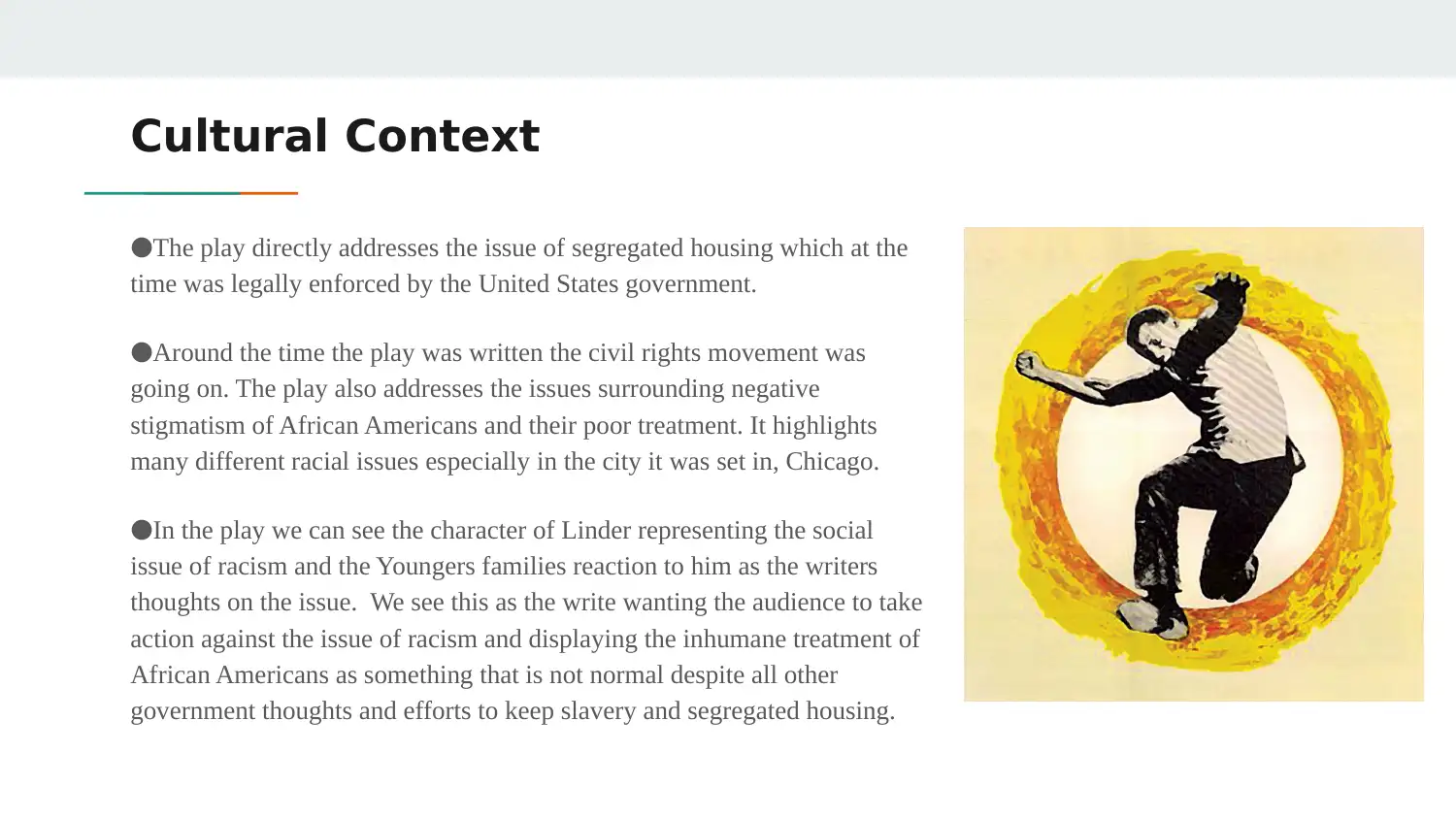
Cultural Context
●The play directly addresses the issue of segregated housing which at the
time was legally enforced by the United States government.
●Around the time the play was written the civil rights movement was
going on. The play also addresses the issues surrounding negative
stigmatism of African Americans and their poor treatment. It highlights
many different racial issues especially in the city it was set in, Chicago.
●In the play we can see the character of Linder representing the social
issue of racism and the Youngers families reaction to him as the writers
thoughts on the issue. We see this as the write wanting the audience to take
action against the issue of racism and displaying the inhumane treatment of
African Americans as something that is not normal despite all other
government thoughts and efforts to keep slavery and segregated housing.
●The play directly addresses the issue of segregated housing which at the
time was legally enforced by the United States government.
●Around the time the play was written the civil rights movement was
going on. The play also addresses the issues surrounding negative
stigmatism of African Americans and their poor treatment. It highlights
many different racial issues especially in the city it was set in, Chicago.
●In the play we can see the character of Linder representing the social
issue of racism and the Youngers families reaction to him as the writers
thoughts on the issue. We see this as the write wanting the audience to take
action against the issue of racism and displaying the inhumane treatment of
African Americans as something that is not normal despite all other
government thoughts and efforts to keep slavery and segregated housing.
Paraphrase This Document
Need a fresh take? Get an instant paraphrase of this document with our AI Paraphraser

CULTURAL CONTEXT (CONT…..)
● This play is also a indirect autobiography of the playwrights life. It
depicts Lorraine Hansberry’s life and how she had moved from a
segregated poorer neighborhood to a white majority “rich”
neighborhood, as well as all the issues and setbacks that came with it.
● Events throughout the play can be compared to real life events that
happened regarding the civil rights movements and issues of this
time.
● Thus, it can be said that the play is deeply ingrained into the culture
and the social background of the American society and also the lives
of the black-skinned community members
● This play is also a indirect autobiography of the playwrights life. It
depicts Lorraine Hansberry’s life and how she had moved from a
segregated poorer neighborhood to a white majority “rich”
neighborhood, as well as all the issues and setbacks that came with it.
● Events throughout the play can be compared to real life events that
happened regarding the civil rights movements and issues of this
time.
● Thus, it can be said that the play is deeply ingrained into the culture
and the social background of the American society and also the lives
of the black-skinned community members
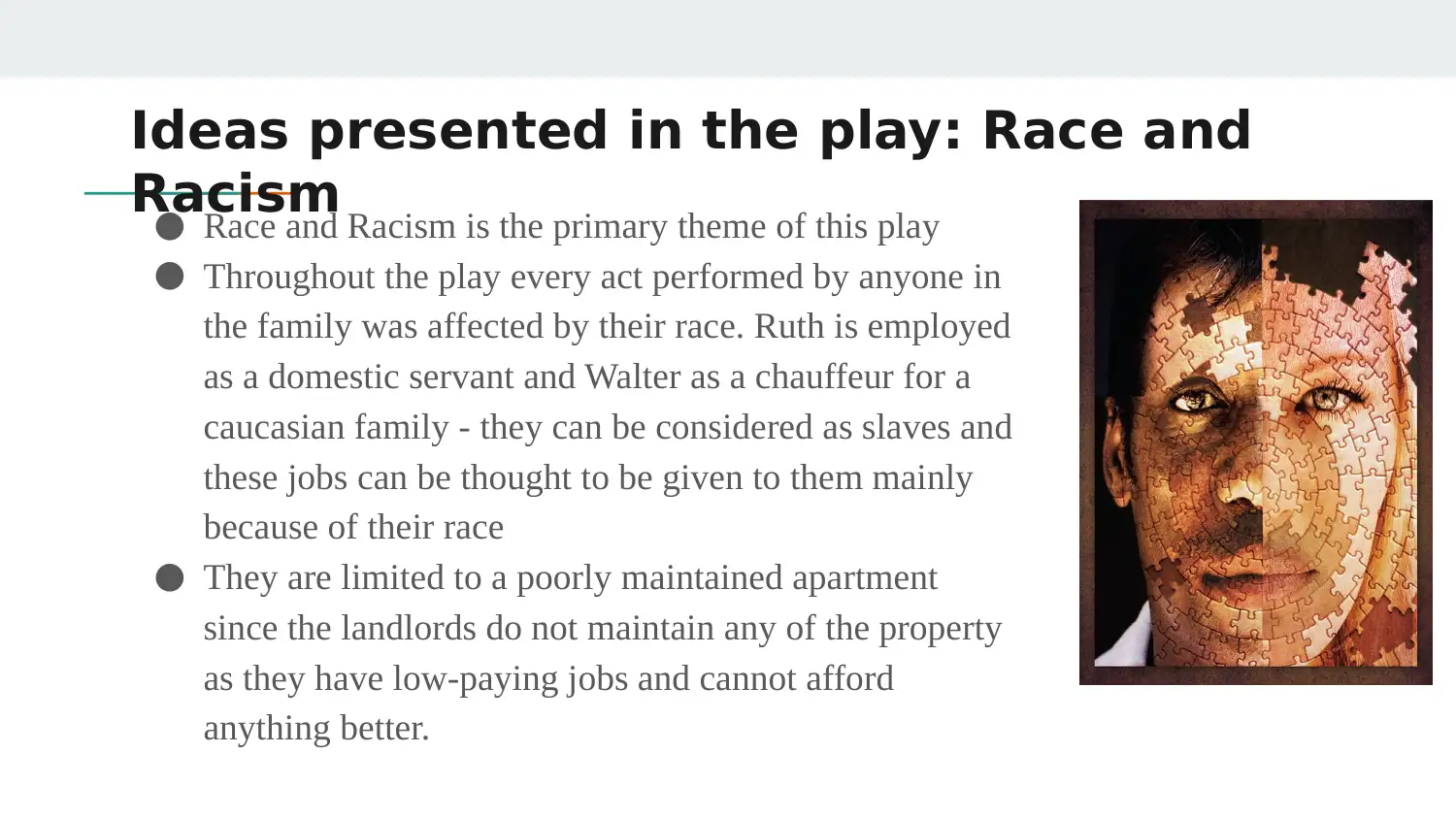
Ideas presented in the play: Race and
Racism● Race and Racism is the primary theme of this play
● Throughout the play every act performed by anyone in
the family was affected by their race. Ruth is employed
as a domestic servant and Walter as a chauffeur for a
caucasian family - they can be considered as slaves and
these jobs can be thought to be given to them mainly
because of their race
● They are limited to a poorly maintained apartment
since the landlords do not maintain any of the property
as they have low-paying jobs and cannot afford
anything better.
Racism● Race and Racism is the primary theme of this play
● Throughout the play every act performed by anyone in
the family was affected by their race. Ruth is employed
as a domestic servant and Walter as a chauffeur for a
caucasian family - they can be considered as slaves and
these jobs can be thought to be given to them mainly
because of their race
● They are limited to a poorly maintained apartment
since the landlords do not maintain any of the property
as they have low-paying jobs and cannot afford
anything better.
⊘ This is a preview!⊘
Do you want full access?
Subscribe today to unlock all pages.

Trusted by 1+ million students worldwide
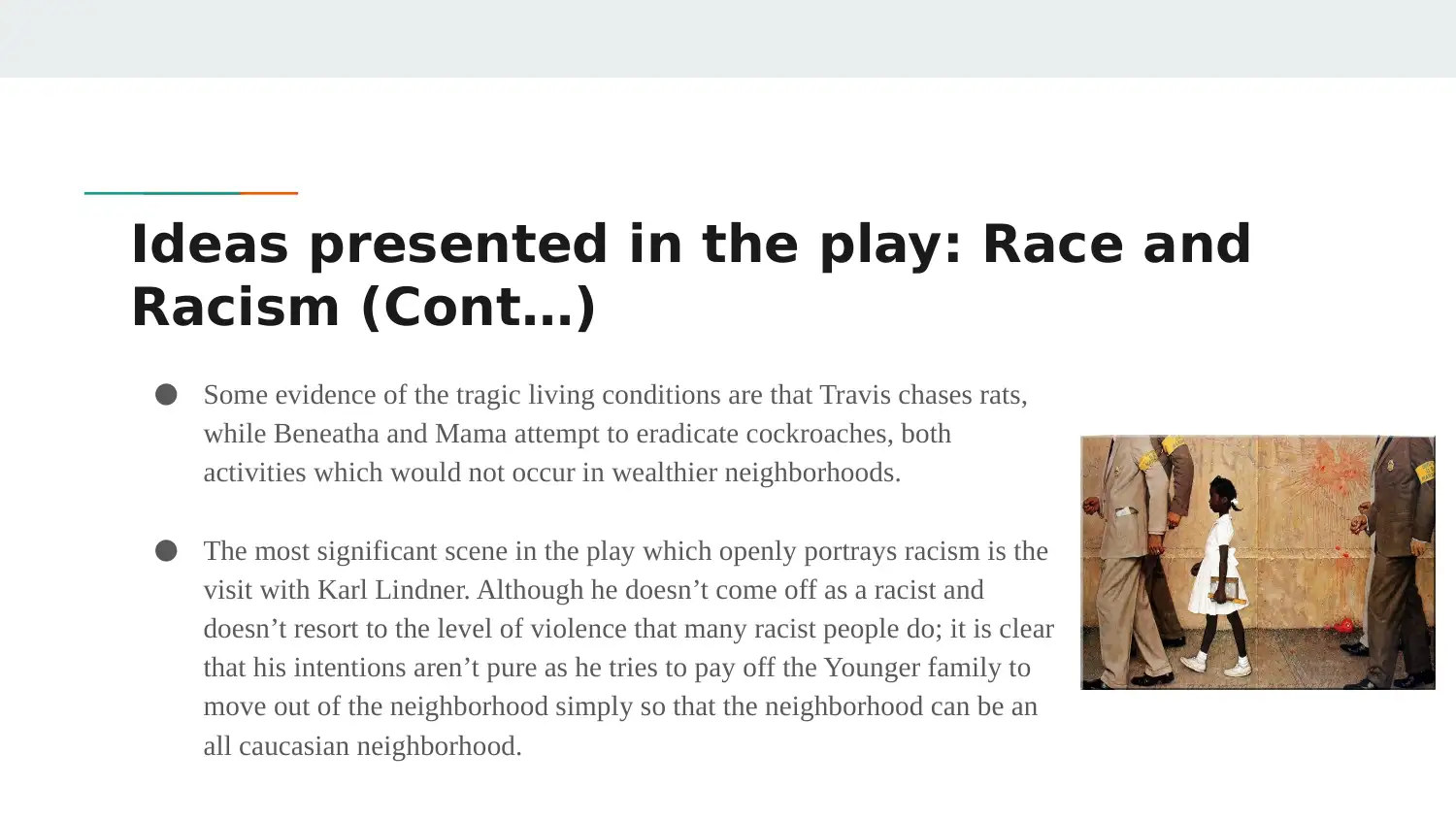
Ideas presented in the play: Race and
Racism (Cont…)
● Some evidence of the tragic living conditions are that Travis chases rats,
while Beneatha and Mama attempt to eradicate cockroaches, both
activities which would not occur in wealthier neighborhoods.
● The most significant scene in the play which openly portrays racism is the
visit with Karl Lindner. Although he doesn’t come off as a racist and
doesn’t resort to the level of violence that many racist people do; it is clear
that his intentions aren’t pure as he tries to pay off the Younger family to
move out of the neighborhood simply so that the neighborhood can be an
all caucasian neighborhood.
Racism (Cont…)
● Some evidence of the tragic living conditions are that Travis chases rats,
while Beneatha and Mama attempt to eradicate cockroaches, both
activities which would not occur in wealthier neighborhoods.
● The most significant scene in the play which openly portrays racism is the
visit with Karl Lindner. Although he doesn’t come off as a racist and
doesn’t resort to the level of violence that many racist people do; it is clear
that his intentions aren’t pure as he tries to pay off the Younger family to
move out of the neighborhood simply so that the neighborhood can be an
all caucasian neighborhood.
Paraphrase This Document
Need a fresh take? Get an instant paraphrase of this document with our AI Paraphraser
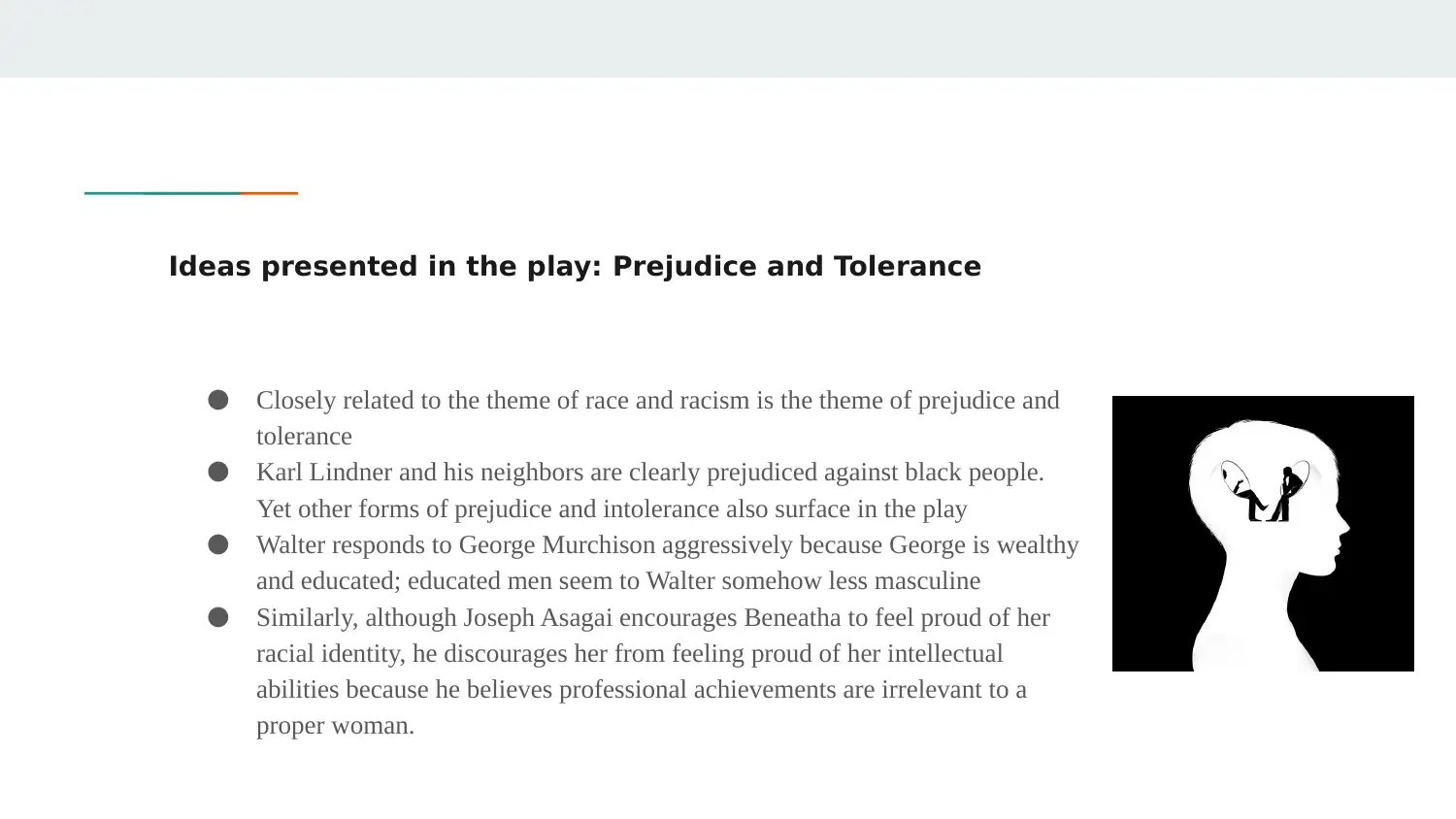
Ideas presented in the play: Prejudice and Tolerance
● Closely related to the theme of race and racism is the theme of prejudice and
tolerance
● Karl Lindner and his neighbors are clearly prejudiced against black people.
Yet other forms of prejudice and intolerance also surface in the play
● Walter responds to George Murchison aggressively because George is wealthy
and educated; educated men seem to Walter somehow less masculine
● Similarly, although Joseph Asagai encourages Beneatha to feel proud of her
racial identity, he discourages her from feeling proud of her intellectual
abilities because he believes professional achievements are irrelevant to a
proper woman.
● Closely related to the theme of race and racism is the theme of prejudice and
tolerance
● Karl Lindner and his neighbors are clearly prejudiced against black people.
Yet other forms of prejudice and intolerance also surface in the play
● Walter responds to George Murchison aggressively because George is wealthy
and educated; educated men seem to Walter somehow less masculine
● Similarly, although Joseph Asagai encourages Beneatha to feel proud of her
racial identity, he discourages her from feeling proud of her intellectual
abilities because he believes professional achievements are irrelevant to a
proper woman.
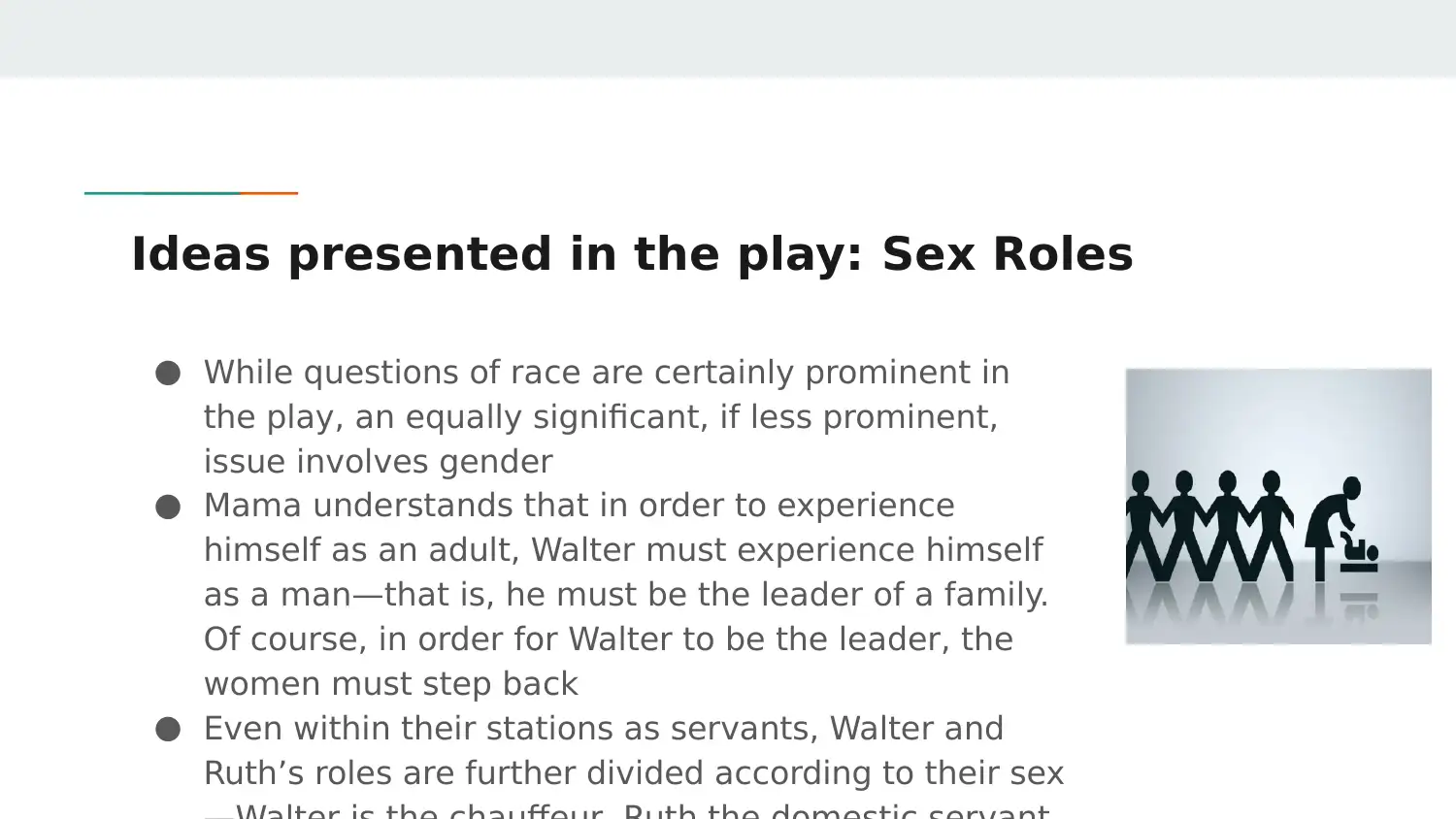
Ideas presented in the play: Sex Roles
● While questions of race are certainly prominent in
the play, an equally significant, if less prominent,
issue involves gender
● Mama understands that in order to experience
himself as an adult, Walter must experience himself
as a man—that is, he must be the leader of a family.
Of course, in order for Walter to be the leader, the
women must step back
● Even within their stations as servants, Walter and
Ruth’s roles are further divided according to their sex
● While questions of race are certainly prominent in
the play, an equally significant, if less prominent,
issue involves gender
● Mama understands that in order to experience
himself as an adult, Walter must experience himself
as a man—that is, he must be the leader of a family.
Of course, in order for Walter to be the leader, the
women must step back
● Even within their stations as servants, Walter and
Ruth’s roles are further divided according to their sex
⊘ This is a preview!⊘
Do you want full access?
Subscribe today to unlock all pages.

Trusted by 1+ million students worldwide
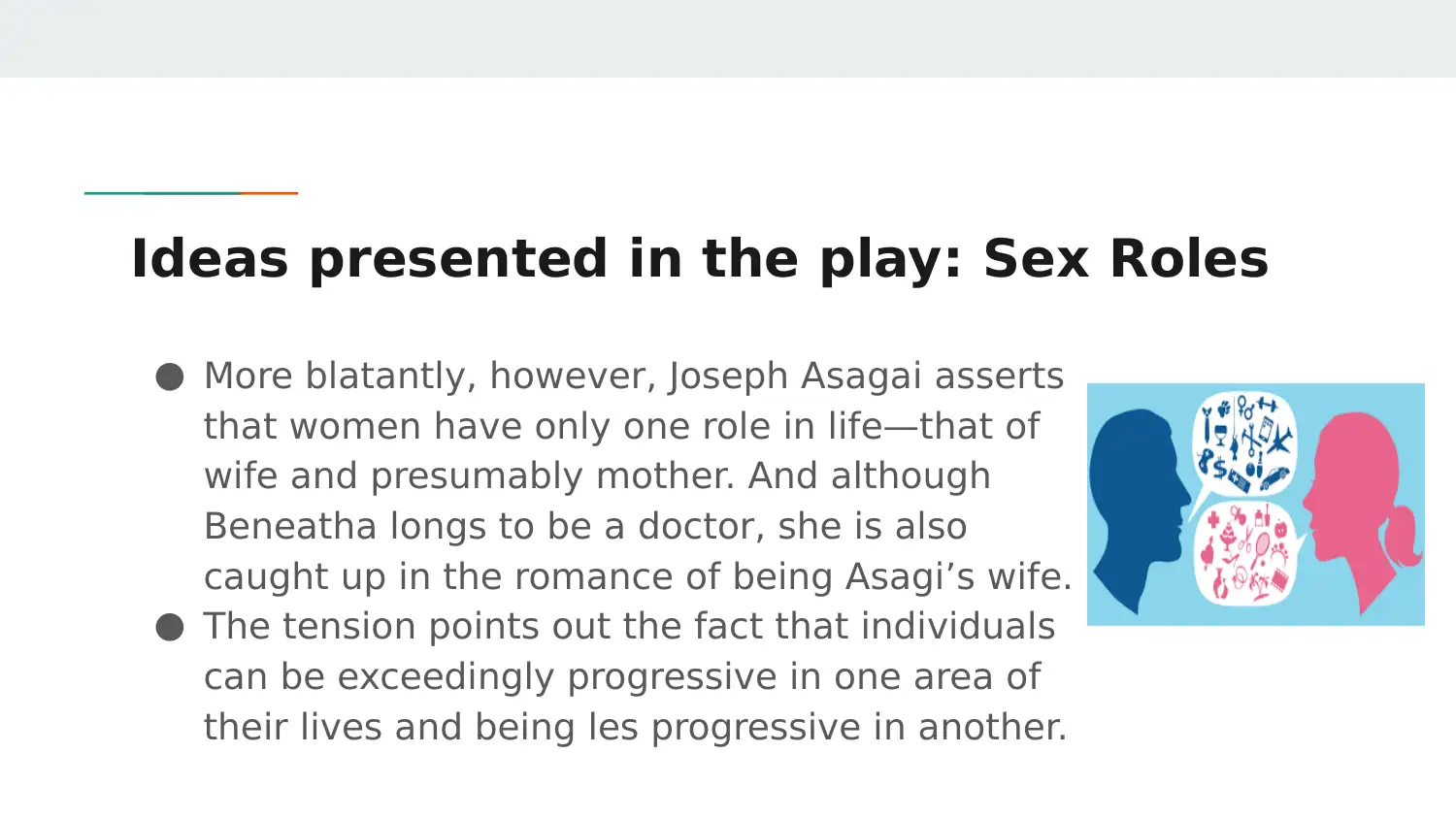
Ideas presented in the play: Sex Roles
● More blatantly, however, Joseph Asagai asserts
that women have only one role in life—that of
wife and presumably mother. And although
Beneatha longs to be a doctor, she is also
caught up in the romance of being Asagi’s wife.
● The tension points out the fact that individuals
can be exceedingly progressive in one area of
their lives and being les progressive in another.
● More blatantly, however, Joseph Asagai asserts
that women have only one role in life—that of
wife and presumably mother. And although
Beneatha longs to be a doctor, she is also
caught up in the romance of being Asagi’s wife.
● The tension points out the fact that individuals
can be exceedingly progressive in one area of
their lives and being les progressive in another.
Paraphrase This Document
Need a fresh take? Get an instant paraphrase of this document with our AI Paraphraser
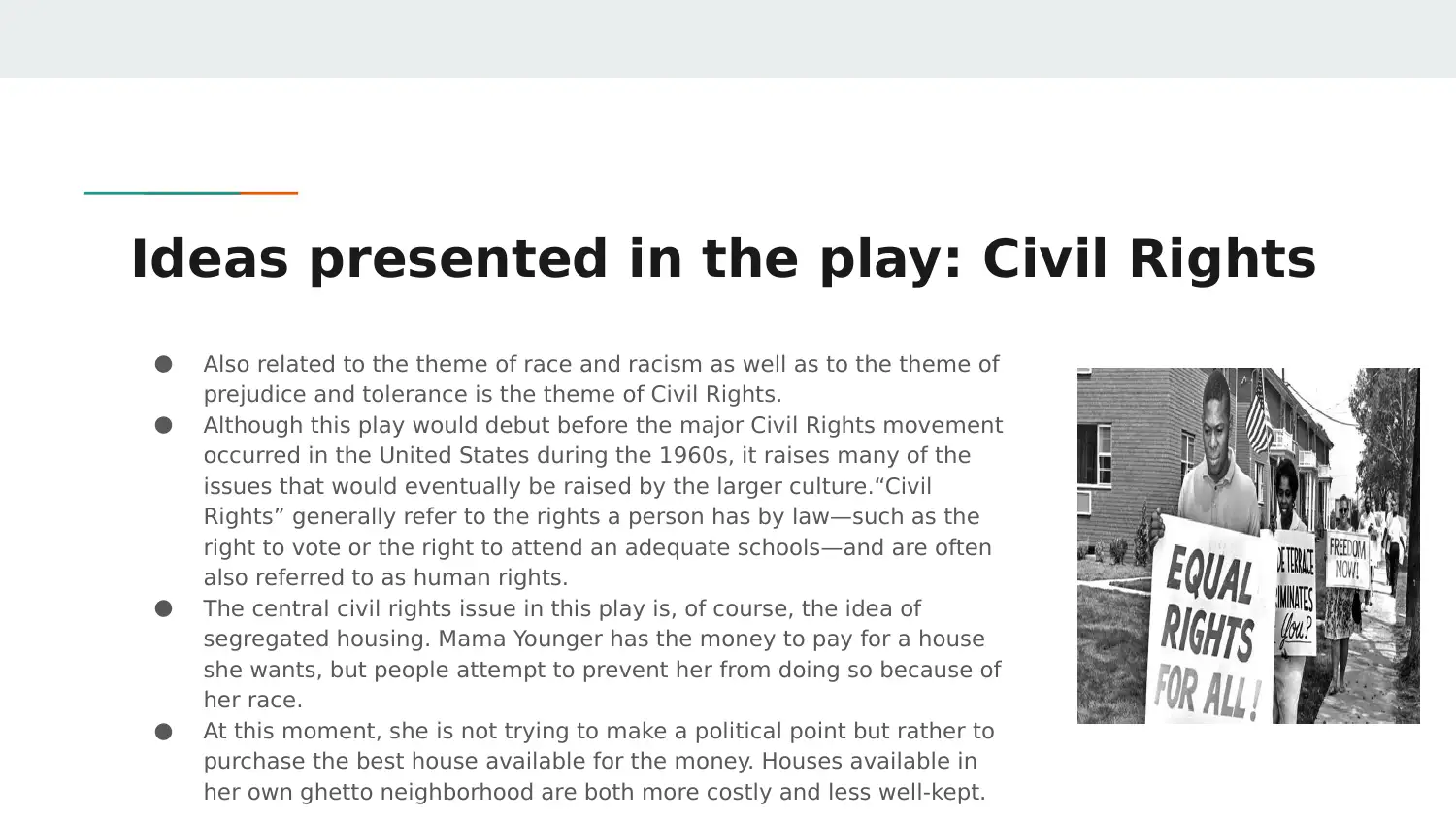
Ideas presented in the play: Civil Rights
● Also related to the theme of race and racism as well as to the theme of
prejudice and tolerance is the theme of Civil Rights.
● Although this play would debut before the major Civil Rights movement
occurred in the United States during the 1960s, it raises many of the
issues that would eventually be raised by the larger culture.“Civil
Rights” generally refer to the rights a person has by law—such as the
right to vote or the right to attend an adequate schools—and are often
also referred to as human rights.
● The central civil rights issue in this play is, of course, the idea of
segregated housing. Mama Younger has the money to pay for a house
she wants, but people attempt to prevent her from doing so because of
her race.
● At this moment, she is not trying to make a political point but rather to
purchase the best house available for the money. Houses available in
her own ghetto neighborhood are both more costly and less well-kept.
● Also related to the theme of race and racism as well as to the theme of
prejudice and tolerance is the theme of Civil Rights.
● Although this play would debut before the major Civil Rights movement
occurred in the United States during the 1960s, it raises many of the
issues that would eventually be raised by the larger culture.“Civil
Rights” generally refer to the rights a person has by law—such as the
right to vote or the right to attend an adequate schools—and are often
also referred to as human rights.
● The central civil rights issue in this play is, of course, the idea of
segregated housing. Mama Younger has the money to pay for a house
she wants, but people attempt to prevent her from doing so because of
her race.
● At this moment, she is not trying to make a political point but rather to
purchase the best house available for the money. Houses available in
her own ghetto neighborhood are both more costly and less well-kept.
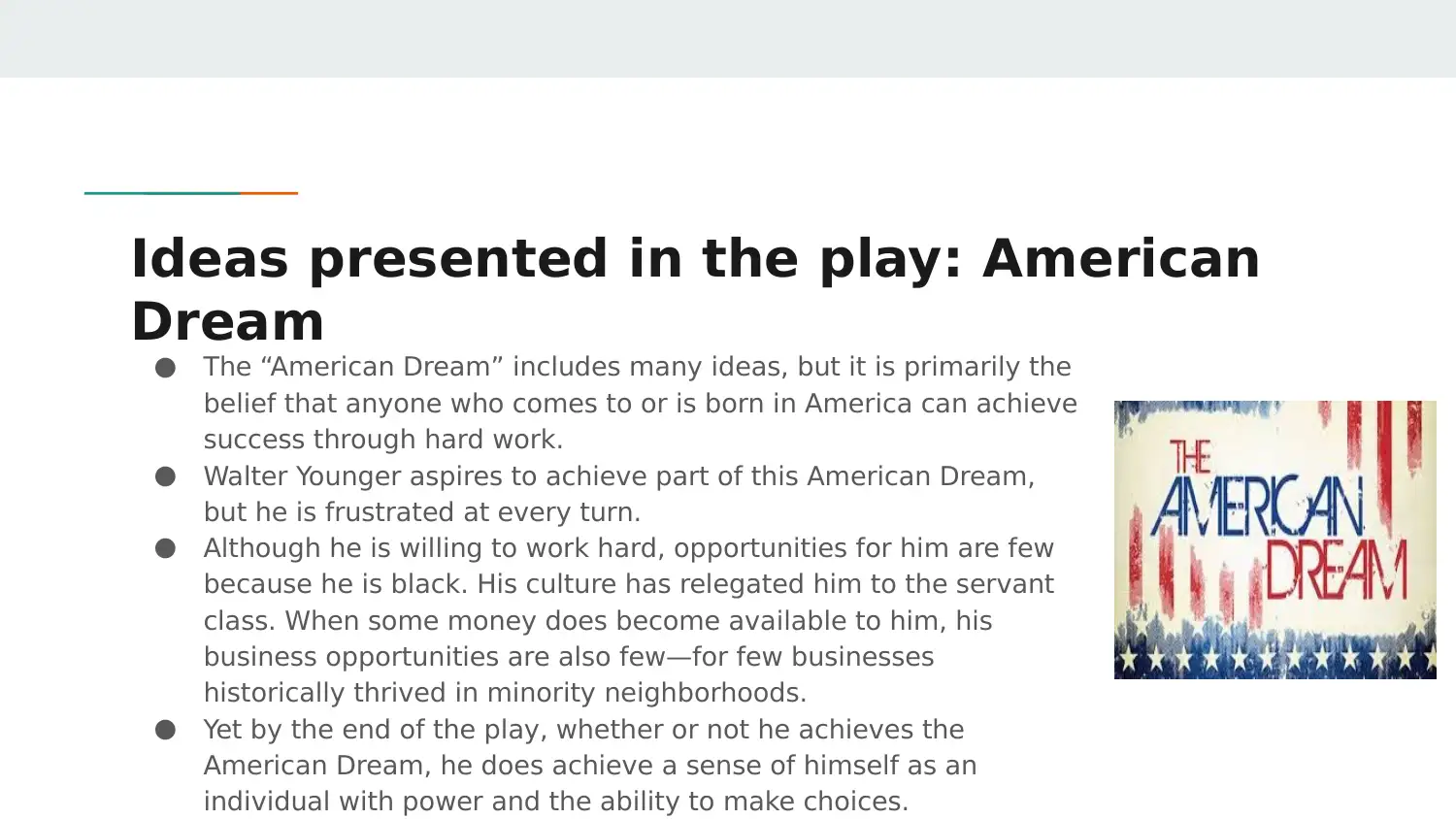
Ideas presented in the play: American
Dream
● The “American Dream” includes many ideas, but it is primarily the
belief that anyone who comes to or is born in America can achieve
success through hard work.
● Walter Younger aspires to achieve part of this American Dream,
but he is frustrated at every turn.
● Although he is willing to work hard, opportunities for him are few
because he is black. His culture has relegated him to the servant
class. When some money does become available to him, his
business opportunities are also few—for few businesses
historically thrived in minority neighborhoods.
● Yet by the end of the play, whether or not he achieves the
American Dream, he does achieve a sense of himself as an
individual with power and the ability to make choices.
Dream
● The “American Dream” includes many ideas, but it is primarily the
belief that anyone who comes to or is born in America can achieve
success through hard work.
● Walter Younger aspires to achieve part of this American Dream,
but he is frustrated at every turn.
● Although he is willing to work hard, opportunities for him are few
because he is black. His culture has relegated him to the servant
class. When some money does become available to him, his
business opportunities are also few—for few businesses
historically thrived in minority neighborhoods.
● Yet by the end of the play, whether or not he achieves the
American Dream, he does achieve a sense of himself as an
individual with power and the ability to make choices.
⊘ This is a preview!⊘
Do you want full access?
Subscribe today to unlock all pages.

Trusted by 1+ million students worldwide
1 out of 23
Your All-in-One AI-Powered Toolkit for Academic Success.
+13062052269
info@desklib.com
Available 24*7 on WhatsApp / Email
![[object Object]](/_next/static/media/star-bottom.7253800d.svg)
Unlock your academic potential
Copyright © 2020–2025 A2Z Services. All Rights Reserved. Developed and managed by ZUCOL.
